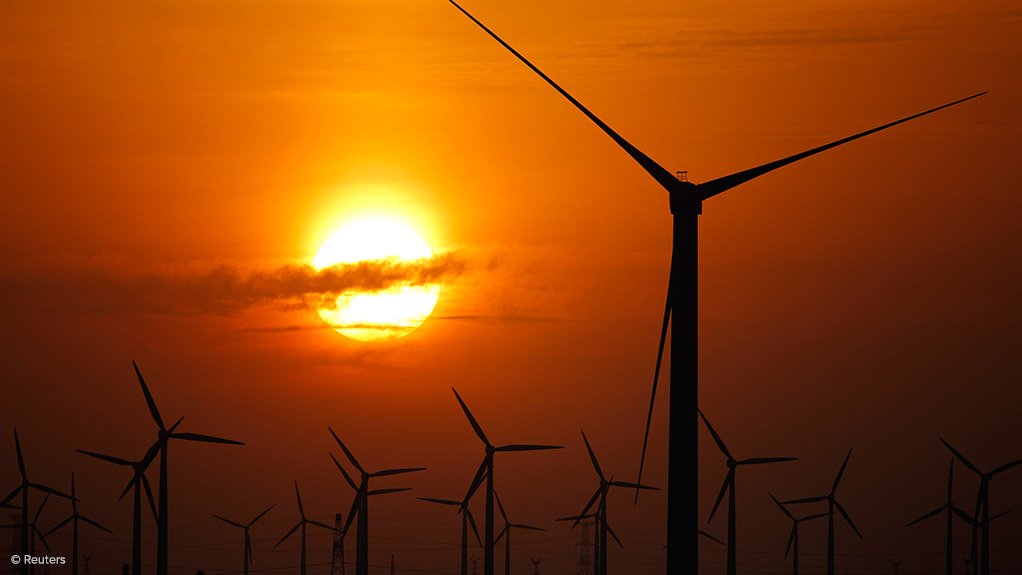Global professional services firm WSP | Parsons Brinckerhoff Africa highlights that there is great potential for wind energy as a suitable energy source for South Africa. The company notes that the first wind farms are already on the grid and contribute to South Africa’s energy supply.
Three utility-scale wind farms are already up and running in South Africa – the Hopefield wind farm, in the Western Cape; the Van Stadens wind farm in the Eastern Cape; and the Klipheuwel Dassiesfontein wind farm, near Caledon, in the Western Cape.
When combined, these wind farms contribute 120 MW of capacity into the regional grid, notes the company.
Additionally, there is the 138 MW Jeffreys Bay wind farm, in the Eastern Cape, where 60 wind turbines have been commissioned. The farm, which spans 3 700 ha, will supply 460 000 MWh/y, which is enough clean, renewable electrical energy to power 100 000 average South African households. The project is also expected to cut annual carbon emissions by 420 000 t.
Other wind energy projects, approved under bid window one of government’s Renewable Energy Independent Power Producer Procurement Programme, are expected to reach commercial operation within the next few months, while wind farms already being developed in bid window two and three will add another 1 421 MW to the grid.
“There are impressive improvements in terms of wind turbine technologies when it comes to the design of these systems,” states WSP | Parsons Brinckerhoff Africa director of power transmission and distribution Dinesh Buldoo.
For instance, there is significant focus on advanced blade manufacturing methods based mainly on alternative manufacturing techniques, such as injection moulding, compression moulding and reaction injection moulding.
Benefits of Wind Energy
“Wind energy is a cleaner fuel source,” notes Buldoo, explaining that air pollution from wind energy is lower than technologies that rely on combustion of fossil fuels, as wind turbines do not produce atmospheric emissions that cause acid rain or emit greenhouse gases.
It is a sustainable source of energy, moreover, as wind is a form of renewable energy. The company advances that wind is caused by the heating of the atmosphere by the sun, the rotation of the earth, and the earth’s surface irregularities. For as long as the sun shines and the wind blows, the energy produced can be harnessed to send power across the grid.
Wind power is also cost-effective. It is one of the lowest-priced renewable-energy technologies available today, costing in the region of 70c/kWh, depending upon the wind resource and the particular project’s financing.
Wind turbines can be built on existing farms which greatly benefits the economy in rural areas, where most of the best wind sites are found. Wind power plant owners make rent payments to the farmer for the use of the land, providing landowners with additional income. Farmers can continue to work the land as the wind turbines use only a fraction of the land.
Further, wind creates jobs. For example, in the US, in 2014, the wind sector invested more than $8-billion of private capital into the economy to build projects and employed more than 73 000 workers. Based on the 2008 US Department of Energy Wind Vision Report, wind has the potential to support more than 600 000 jobs in manufacturing, installation, maintenance and support services by 2050.
“While the wind sector in South Africa – or even Africa – is still in its infancy and can’t be compared in size to the US sector, if we look at these statistics, we can certainly recognise the opportunity that growing the wind sector in South Africa and Africa presents to create jobs,” highlights Buldoo.
Moreover, wind stimulates the economy and foreign investment. The growth in the wind energy sector results in an influx of foreign investment through the encouragement of local participation in the supply chain in terms of manufacturing, supply of components and construction.
Potential for Investment
WSP explains that, as part of helping potential investors seek out good opportunities, South Africa’s Wind Atlas has been developed. The Wind Atlas of South Africa can find applications in at least two areas, namely to assist in the development of large grid-connected wind farms and to provide more accurate wind resource data to identify potential off-grid electrification opportunities. The Wind Atlas – developed in conjunction with the Danish government and the United Nations Development Programme as well as several other partners – will help industry and government identify excellent wind development zones.
The Wind Atlas has been mapping the Western Cape and parts of the Northern Cape and the Eastern Cape, notes Buldoo. More funding from the Danish government will see the Wind Atlas being expanded into the remaining areas of the Eastern Cape, KwaZulu-Natal and parts of the Free State.
Edited by: Zandile Mavuso
Creamer Media Senior Deputy Editor: Features
EMAIL THIS ARTICLE SAVE THIS ARTICLE
To subscribe email subscriptions@creamermedia.co.za or click here
To advertise email advertising@creamermedia.co.za or click here













